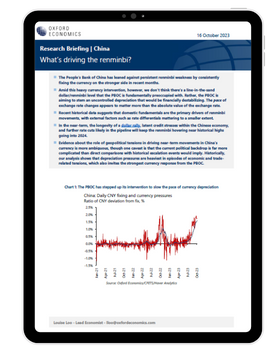What’s driving the renminbi in China?

The People’s Bank of China has leaned against persistent renminbi weakness by consistently fixing the currency on the stronger side in recent months. Amid this heavy currency intervention, however, we don’t think there’s a line-in-the-sand dollar/renminbi level that the PBOC is fundamentally preoccupied with. Rather, the central bank is concerned with ensuring that depreciation expectations remain anchored.
What you will learn:
- Recent historical data suggests that domestic fundamentals are the primary drivers of renminbi movements, with external factors such as rate differentials mattering to a smaller extent.
- In the near-term, the longevity of a dollar rally, latent credit stresses within the Chinese economy, and further rate cuts likely in the pipeline will keep the renminbi hovering near historical highs going into 2024.
- Evidence about the role of geopolitical tensions in driving near-term movements in China’s currency is more ambiguous, though one caveat is that the current political backdrop is far more complicated than direct comparisons with historical escalation events would imply.
- Historically, our analysis shows that depreciation pressures are heaviest in episodes of economic and trade-related tensions, which also invites the strongest currency response from the PBOC.
Tags:
Related Posts

Post
Tariffs and Politics Leave the BoJ Powerless in Japan
The Bank of Japan kept its policy rate at 0.5% at its July meeting. We continue to think the BoJ will exercise caution on rate hikes despite still-high inflation and a recent trade deal with the US.
Find Out More
Post
Catalyzing Africa’s Sustainable Transition: Insights to Impact a Climate-Resilient Future
Sustainable finance is not merely a climate imperative but a development necessity. As climate risks intensify, Africa must urgently mobilise capital to advance its adaptation, mitigation, and development goals. Realising this ambition will require coordinated action across governments, financial institutions, international partners, multilateral agencies, and the private sector. With bold leadership, innovative tools, and supportive ecosystems, the continent can chart a path toward a more inclusive, resilient, and sustainable global economy.
Find Out More
Post
Japan’s worsening fiscal outlook raises risk of higher term premium
We expect Japan's fiscal outlook to deteriorate due to weak economic growth and pressure on the government to implement fiscal stimulus. We don't think deficit concerns drove the recent spike in ultra-long Japanese government bond (JGB) yields, but as domestic purchasers reduce their JGB holdings, long-term yields could become more sensitive to fiscal developments in the coming quarters, raising the risk of a higher term premium.
Find Out More